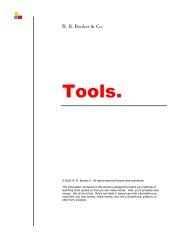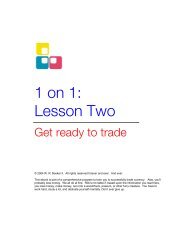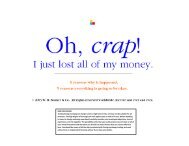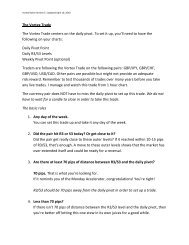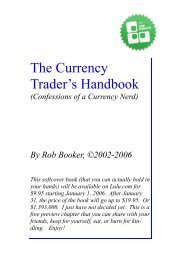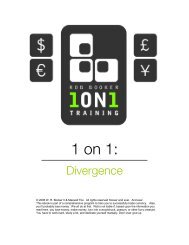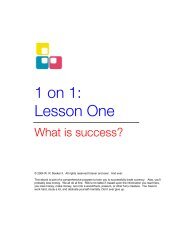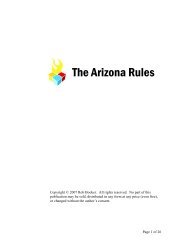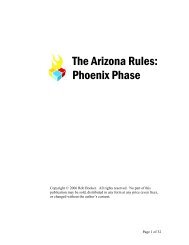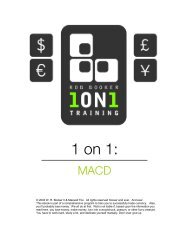Create successful ePaper yourself
Turn your PDF publications into a flip-book with our unique Google optimized e-Paper software.
W. R. <strong>Booker</strong> & Co.<br />
1 on 1:<br />
Day 7<br />
The <strong>Bollinger</strong> <strong>Bands</strong>.<br />
© 2004 W. R. <strong>Booker</strong> II. All rights reserved forever and ever. And ever.<br />
The information contained in this ebook is designed to teach you methods of<br />
watching forex quotes so that you can make money. <strong>Bollinger</strong> <strong>Bands</strong> are my<br />
favorite tool.
<strong>Bollinger</strong> <strong>Bands</strong>.<br />
________________________________________<br />
Day 7 – page 2<br />
Using <strong>Bollinger</strong> <strong>Bands</strong> is quite easy. These <strong>Bands</strong> predict price movement based<br />
on market volatility. When price is more volatile, the <strong>Bands</strong> are wider. When the<br />
market is quiet, the <strong>Bands</strong> tighten together. Price tends to move back to the center of<br />
the <strong>Bands</strong>. As you can expect, if price tends to move back to the center of the <strong>Bands</strong>,<br />
then what should happen on the far right edge of the chart above?<br />
When price breaks outside a Band, it signals a buy or sell order. In the chart above,<br />
you see on the far right edge that the candles jump outside of the top Band. Because<br />
the candles exceeded the top Band (by quite a bit), we can expect that it is going to<br />
settle back down again. Here are the next few candles on the chart:
Day 7 – page 3<br />
As you can see, the price tended to move back to center. This trade is especially<br />
powerful when the move touched resistance (or support on the downside), but was not<br />
able to break through. To time an entry on this trade, simply chart a lower time frame<br />
(in this case the 30 min or the 10 min chart) and wait for the reversal to show up on<br />
that chart … and then enter a trade. This would be a classic “<strong>Bollinger</strong> Bounce” trade<br />
– when the candles bounce off the top band and go back to center, or they bounce off<br />
the bottom band, and go back to center.<br />
The <strong>Bands</strong> themselves show a certain level of support and resistance, and many<br />
traders have developed strategies that simply trade the <strong>Bollinger</strong> Bounce – entering at<br />
the extremes and selling a the opposite extreme, with stops placed at the center (where<br />
the price tends to reach no matter what). This can be profitable, but tricky, as<br />
sometimes price movement keeps expanding the <strong>Bands</strong> on the up- or down-side, as in<br />
a trending market:
Day 7 – page 4<br />
When a Band widens as price approaches, it’s a good sign that further movement in<br />
the direction of the Band can be expected. When a Band flattens as price approaches,<br />
it signals that price might bounce off the Band, or violate the Band and then drop back<br />
to center. If the Band flattens as price approaches, but then widens a bit – make sure<br />
you’re ready for a possible breakout. More on that in a moment.<br />
See the second chart again: what’s happening to the lower Band as the price<br />
approaches the center (following that breakout and reversal)? The lower Band is<br />
dropping through the floor. Any ideas on what’s going to happen next?<br />
The price is bound to drop further. See the chart below, which represents the next<br />
few candles:
Day 7 – page 5<br />
Use <strong>Bollinger</strong> <strong>Bands</strong> in combination with other indicators. For example, in the<br />
chart above, as soon as the price approached center, and the lower Band widened, you<br />
could also see the MACD start to produce red bars. This was a great indicator that<br />
bears were beginning to take control. We would know the bear move was over when<br />
the lower Band began to tighten up – which it’s not doing in the chart above. This<br />
would signal further price declines (which in fact is exactly what happened).<br />
To summarize, it’s important to track the following when using <strong>Bollinger</strong> <strong>Bands</strong>:<br />
1. How wide are the <strong>Bands</strong>? Wider <strong>Bands</strong> represent volatile markets.<br />
2. Do the <strong>Bands</strong> expand or flatten as price approaches?<br />
3. What does the MACD tell you when you compare it?<br />
4. Compare longer time-frame charts with shorter ones – and chart the <strong>Bollinger</strong><br />
<strong>Bands</strong> on both.<br />
5. Remember that eventually, price tends back to center.
The <strong>Bollinger</strong> Squeeze.<br />
________________________________________<br />
The <strong>Bollinger</strong> Squeeze is probably one of my favorite systems, and it is pictured<br />
above. Essentially, the <strong>Bands</strong> contract and “squeeze” the candles, finally<br />
culminating in a breakout.<br />
Here are the elements of a Squeeze:<br />
1. The <strong>Bollinger</strong>s tighten up horizontally on the 15 min chart AND / OR<br />
2. The <strong>Bollinger</strong>s tighten on the 1hr chart<br />
3. The time of day is:<br />
a. The opening of the EUR session<br />
b. Near the release of an important economic report<br />
Day 7 – page 6
That’s the basic setup to watch for. This happens frequently – not for a zillion<br />
pips every time, but it does happen a few times per week. Here’s how to manage<br />
the trade:<br />
How do you time the breakout?<br />
The best breakouts will occur at the opening of the EUR session, or at the<br />
release of some important economic report in the US. The monthly US<br />
unemployment report, any US interest rate decision, and the CPI report are just<br />
three examples.<br />
How do you profit from the breakout?<br />
The best way to take advantage of a trade is to simply place entry orders above<br />
and below the <strong>Bollinger</strong> <strong>Bands</strong> 10 minutes before the release of the economic<br />
report, or near to the open of the EUR session. Or, alternatively, you might place<br />
entry orders above and below the current price (which may be at either extreme of<br />
the <strong>Bollinger</strong>s) right before the release of the news.<br />
What should you watch out for?<br />
Day 7 – page 7<br />
Right before a breakout, the candles might actually perform a fake move – in the<br />
opposite direction of the breakout:
Day 7 – page 8<br />
In the chart above, you can see that just before the huge red candle downward,<br />
the pair actually jumped up a bit. This happens in all time frames, on all pairs, for<br />
nearly every significant breakout. I cannot begin to speculate as to why this<br />
occurs.<br />
But I will say that it does occur, and that you should be aware of it. To prevent<br />
yourself from getting burned, just remember to place your entry orders far enough<br />
away from the current price so as to avoid getting swept up too early in a trade.<br />
If you do find that you get swept into a trade a bit early, then you’re going to<br />
have two things to save you:<br />
1. You’re going to use stops – usually about 30 pips<br />
2. You’re going to be right there and can close the order manually if you feel<br />
that’s the best thing to do.<br />
How many pips should you try to make?<br />
This is the question everyone always asks me. Answer:<br />
Take 10 pips to start. If the <strong>Bollinger</strong> <strong>Bands</strong> have been tight and constricted for<br />
over 4 hours on the 15 min chart, then go for 30 or 40 pips, or even leave the limit<br />
wide open and just let the trade fly. Otherwise, go for 10, and take the pips.<br />
If you feel like you’re missing out on more money – because you’re only taking<br />
10 pips – then experiment cautiously with increasing your limit or deleting the<br />
limit. Just remember than many successful traders lose all of their money by<br />
simply trying too hard to get too many pips.<br />
Practice makes perfect<br />
As with any strategy, you must practice this one in order for it to become<br />
profitable consistently. Check out the historical charts – look back as far as you<br />
can on the 15 min charts, and watch for where the <strong>Bollinger</strong> <strong>Bands</strong> tighten up.<br />
What kind of trading opportunities do you see? Which ones would you take? What<br />
other indicators help you decide to take the trade (or not)?



